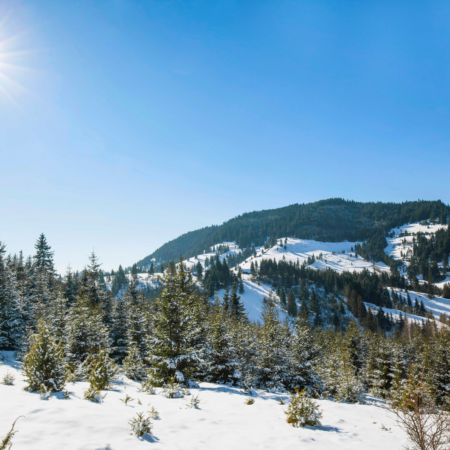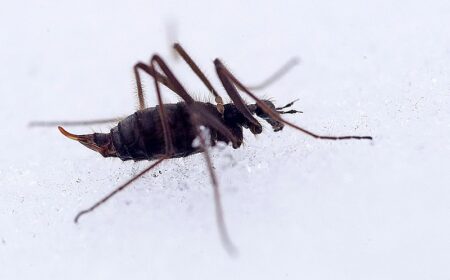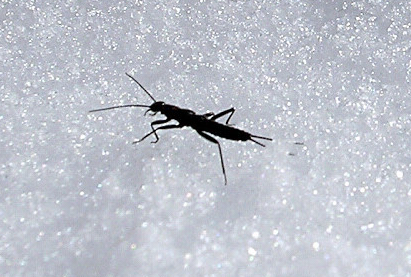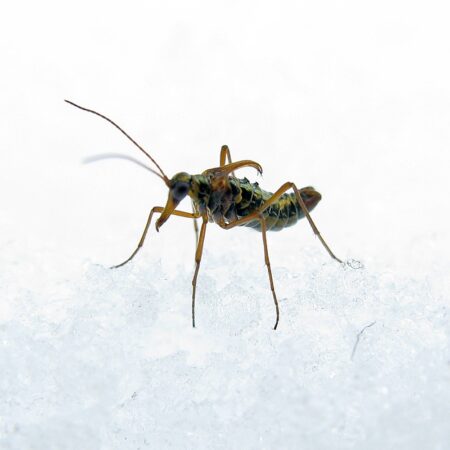For those who don’t like bugs, winter is a great time to spend time outdoors. The usual biting insects are gone, and even ticks are less active. While insects have many clever ways of surviving winter, there are nonetheless a small number that stay active. These mind-blowing winter bugs are a real source of excitement for nature nerds like me, and pose no risk to people or their pets.
In this Deep Stuff post, let’s get to know these unusual winter-active bugs and how they do what they do.
How do bugs stay active in winter?

Before meeting these incredible critters, it’s also worth knowing how they do what they do. These are truly surprising animals! Walking through through feet of snow during an icy winter in Glacier National Park, I was astonished to find long-legged insects hiking alongside me in the cold. How exactly do they stay active when temperatures are well below freezing?
The bugs I’ll mention here use many of the same strategies to thrive in Winter. However, many of them are only distantly related to each other. This means that they have independently developed these common traits to deal with the challenges of winter. Biologists call this phenomenon convergent evolution. Here are some of the ways these critters make their lifestyle work:
- Antifreeze for blood. Although the exact chemicals may vary, invertebrates that hang out in cold climates accumulate chemicals in their bodies that delay freezing. This allows them to supercool, or get below freezing without having crystals form inside them. Since freezing usually means death, these chemicals (often sugars) are a huge help.
- Dark color. By being darkly colored, winter bugs can absorb more of the sun’s energy to stay warm. This can keep them toastier than the surrounding air.
- Long legs. Although not all of them are super lanky, many winter bugs use their tall stature to keep themselves from touching the snow. This way, they can walk around without losing heat or risking freezing through contact with the surrounding ice crystals. Many of these insects also walk around on their tippy-toes for this reason.
- Walking on the ground. Although they are elevated off of the snow, these bugs tend to stay close to the ground. This keeps them within the boundary layer, the stagnant air that hovers just above the ground. This less-mobile air has fewer breezes and keeps the bugs from losing heat to wind.
Now on to the bugs!
Snow fleas and Glacier fleas

Snow fleas (Hypogastrura nivicola) are often the first winter bug that people come across. Approaching what may look like a sprinkling of pepper or a dark puddle on the snow, folks are often in for a surprise. Sometimes numbering in the tens of thousands, these ancient proto-insects are around all year long but stand out clearly on white snow in winter. They belong to a strange, ancestral group of insects called Springtails (Collembola).
Unlike other insects, springtails don’t have wings at any point in their development. Strangely, they also lack a clear abdomen and thorax, and compound eyes. Like all other springtails, snow fleas are harmless and don’t bite like actual fleas. Furthermore, they’re not related to fleas at all; it’s their ability to jump hundreds of times their body length that earned them the name “flea”.
Snowfleas and their cousins the Glacier fleas (Desoria sp.) eat decaying organic matter or other detritus in the snow. During warmer months, they are typically still active in the leaf litter. They can easily withstand temperature well below freezing, and Glacier fleas can live at the top of frigid mountains!
Snowflies or Snow craneflies

Snowflies were the winter bugs that rocked my world at Glacier National Park. I couldn’t believe my eyes as I watched two of these leggy little things marching like wind-up toys through the snowy woods. These unique flies are related to craneflies, the long-legged, mosquito-like flies that some people call daddy long-legs. Snowflies in the genus Chionea are commonly found in late Winter and early Spring in North America, Europe, and Asia in temperate forests.
These critters have freeze-resistant blood, dark coloration, and long legs to keep warm. However, you may have noticed something else about them from the photo above. As Forrest Gump might put it, “They ain’t got no wings!”
Since insects are exotherms, their bodies don’t maintain a consistent internal temperature like ours do. This can make it very hard, and tiring, to get their body temperatures up. Since flying requires a lot of warm muscles, snowflies (and some other winter bugs!) gave up on it and skipped out on functional wings. Snowflies wings are severely reduced and may only function to help them mate. So much for being “flies”, huh?
Some species of snowflies can withstand temperatures as low as 12°F (-11°C), and adults typically live about 2 months. Amazingly, they don’t seem to eat during this time. They may drink water directly from the snow, but have never been observed to feed. Instead, they march around in search of love, mate, and die.
Winter stoneflies

Stoneflies are an ancient and super cool order of insects (Plecoptera) that spend their early lives underwater. For the winter stoneflies (families Taeniopterygidae and Capniidae), their watery childhoods are a big part of their Wintry lifestyle. Young winter stoneflies, called nymphs, need to live in water that is rich in oxygen. As a result, they do better in colder water, which can hold higher oxygen levels. This means that hanging out in colder places can do winter stoneflies a lot of good.
Winter stonefly nymphs, which have gills and no wings, feed on living and dead plants in the beds of streams and rivers in cold climates. They grow steadily, and molt several times as they get bigger. Eventually, they metamorphose into their adult form, where you’re likely to spot them near bodies of water in Winter. If you’re near a body of water on a winter hike, look for winter stoneflies on:
- Bridges
- Fenceposts
- Trees
- Rocks
- Other structures in or around cold, clean streams
These freeze-resistant adult stoneflies come out to breed and lay eggs. While some do not eat all, other adults will feed on algae, small plants, and lichens around their stream home.
Snow scorpionflies

Scorpionflies are bizarre insects you aren’t likely to spot unless you’re looking for them. These weird-looking creatures aren’t flies at all, but belong to the order Mecoptera. Although they are found around the world, particularly in warmer, more humid climates, scorpionflies are relatively uncommon and not always easy to find. While scorpionflies are uncommon, the winter bugs in this family are an even rarer find!
There are several species in the family Boreidae in North America which, like snowflies, have long legs and no functional wings. There may be as few as 30 species worldwide, which hang out in high elevation and boreal ecosystems in the Northern Hemisphere.
Also like snowflies, snow scorpionflies march along the snow in search of mates and mating sites. These adults tend to feed on cold-hardy, non-vascular plants like mosses and liverworts. They can be found walking, and even jumping (!) along in late Winter and early Spring in places as far North as Canada, Alaska, and Scandinavia.
Amazingly, some researchers think that these bugs might be ancient cousins of actual biting fleas (Siphonaptera)!
Cold-weather midges
Like stoneflies, midges in the family Chironomidae have aquatic babies (larvae), so adults show up near freshwater habitats. Both the adult and larval forms of these non-biting midges are valuable for fishermen as bait. The worm-like larvae are filter feeders that eat algae and microorganisms from the surrounding water.
Midges in the genus Diamesa, also known as snow midges, can hang out in snowy areas around springs and seeps. Both of these types of streams are fed by groundwater, which maintain temperatures above freezing year-round because of the more moderate temperatures belowground. They look a lot like mosquitoes, but have no interest in biting people. In fact, most adults don’t eat at all!
Like other winter bugs, adult Diamesa midges come out to breed in winter when there are fewer predators to pose a risk. They have the same sort of antifreeze in their “blood”, which helps them adapt to sub-freezing temperatures.
Thanks for reading about cool winter bugs!
Have you had a chance to see any of these wild winter insects? Let us know in the comments!

